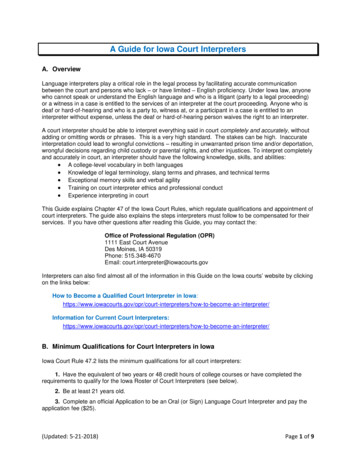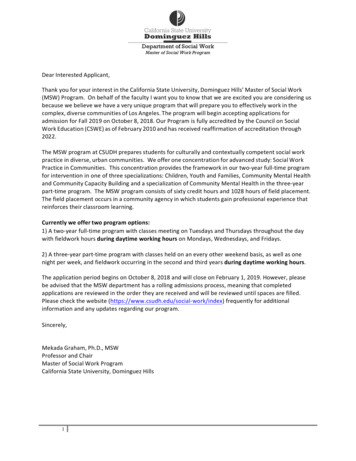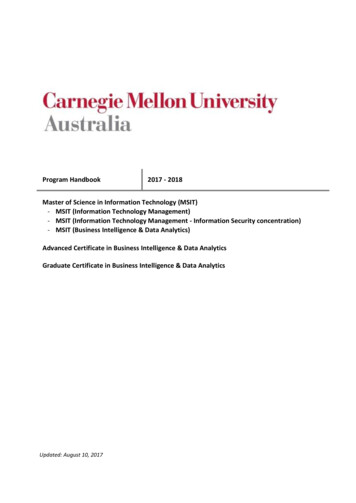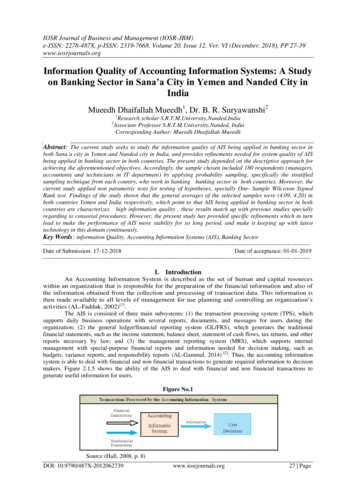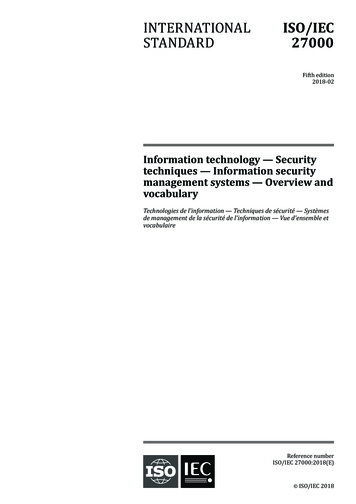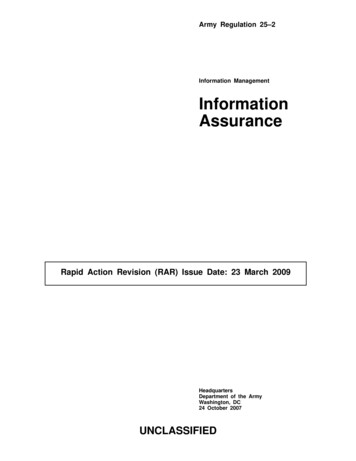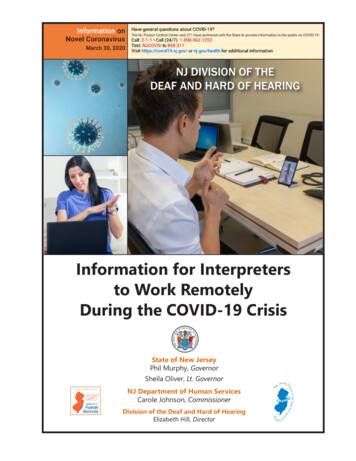
Transcription
NJ DIVISION OF THEDEAF AND HARD OF HEARINGInformation for Interpretersto Work RemotelyDuring the COVID-19 CrisisState of New JerseyPhil Murphy, GovernorSheila Oliver, Lt. GovernorNJ Department of Human ServicesCarole Johnson, CommissionerDivision of the Deaf and Hard of HearingElizabeth Hill, DirectorLorem ipsum
NJ Department of Human ServicesDivision of the Deaf and Hard of HearingInformation for Interpreters to Work Remotely During the COVID-19 CrisisThe New Jersey Division of the Deaf and Hard of Hearing is working to address some anticipated concerns that willbe faced by the deaf and hard of hearing community here in New Jersey as we battle the COVID-19 pandemic.DDHH also wants to provide additional services to the interpreters here in New Jersey who, as independentcontractors, are being hugely impacted, both economically and physically by this virus. To this end, DDHH willserve to coordinate remote interpreting services primarily for medical needs during this critical time.This may be new to many of you who have been providing on-site interpreting services for years. It is a newventure for DDHH as well. Below are some resources to share with you regarding preparation and how to setthese services up in your home if you want to be a resource for remote interpreter services.Suggested Video Remote Interpreting Technical SpecificationsSystem RequirementsAn Internet connection. Ethernet cable is the top choice for any video conference platform (VRS industries usethis method). WiFi with strong upload and download speeds (at least 25 Mbps speed) may be manageable.Wireless depending on the locations and reception area, 3G and 4G/LTE will be able to carry video feeds. Checkyour Internet bandwidth using Speedtest or options provided by your Internet service provider.A microphone – built-in to your computer or USB plug-in or wireless Bluetooth.Built-in headset jack from laptop or desktop. Even if your laptop or desktop has speakers, you must plug in aheadset so that the sound from the speakers does not cause an echo in the Zoom meeting. Any headset with a3.5mm plug will plug in.Microphone/HeadsetA USB headset with microphone and earphones is recommended.WebcamOne that is built-in to your computer or one that connects to your computer via USB. Supported OperatingSystems Mac OS X with MacOS 10.6.8 / (Snow Leopard) or later, Windows 10, Windows 8 or 8.1, Windows 7,Windows Vista with SP1 or later, Windows XP with SP3 or later, Ubuntu 12.04 or higher, Mint 17.1 or higher, RedHat Enterprise Linux 6.4 or higher, Oracle Linux 6.4 or higher, CentOS 6.4 or higher, Fedora 21 or higher,OpenSUSE 13.2 or higher, ArchLinux (64-bit only).Supported Tablet or Mobile DevicesiOS and Android devices, Windows Surface PRO 2 running Win 8.1, Windows Surface PRO 3 running Win 10,Blackberry devices.Supported BrowsersWindows: IE7 , Firefox, Chrome, Safari5 Mac: Safari5 , Firefox, ChromeLinux: Firefox, Chrome.
Recommended Environmental Considerations for VRI Services at HomeLightingAvoid any kind of bright light source directly behind you, regardless of whether it is a light or a window. This willcause what's called 'backlighting' and it will create a halo around your head and make your face appear darker,rendering a harsh and high contrast picture. Lighting behind you will also draw attention to whatever is in thebackground that could potentially be distracting.Many retailers sell various lighting equipment and stands. Look for daylight-balanced LED dimmable lights withstands for maximum flexibility, if you have space.If your space is limited, on-device lighting is a viable alternative. You will need to mount the above near thedevice, a small tabletop tripod may be a necessity.ProportionalityThis refers to the size of your head/upper body within the picture that the viewer sees. Try to position thecamera/device so that everything from the top of your head to a little above your waist is visible. Including morethan is necessary, makes your picture smaller and your signing harder to understand, especially when you arefingerspelling or working with somebody of whom you know that they depend to some degree on speech reading.BackgroundThis goes without saying, but it should be plain and uncluttered. Avoid setting up your camera or device whereyou are likely to have distracting elements or where other household members walk by. Anticipate your dailyroutine and set up someplace where you are not likely to be disturbed or distracted either by somebody walkingbehind you, or somebody walking in front of you. You can search retailers for a wide variety of collapsible ormuslin photographic backgrounds that you can use to place behind you to create a uniform experience even if youhave to move to another location within your home.If you are unable to find a 'natural' location in your home, like a table, a laptop floor stand may be what you need.SoundThe hearing person for whom you are interpreting can hear everything going on at your end unless you mute themicrophone when you are not actively voicing. If you cannot keep noise to a minimum, familiarize yourself withhow to quickly mute and unmute your end of the conversation. If you have not already done so, invest in goodquality headphones, preferably with noise cancellation capability, that have an included microphone function.This will at least allow you to screen out any background noise happening in your environment.Camera angleIt is imperative that the interpreter test how they will appear to the consumer and verify that the image is optimalfor the job before proceeding. If it all possible try to set up your camera or device in such a way that you appear tobe looking at somebody from eye level. This is after all how we normally communicate, and if you happen to besitting at a low table using a laptop and you tilt the camera and screen upward, it will be an extremely unflatteringangle of you. The Deaf person will feel like they are a looking up at you, which is not a natural angle. It should beeasy for most to find some books or boxes if nothing else is at hand, to raise the device to eye level.
If you are unable to find a 'natural' location in your home, like a table, a laptop floor stand may be what you need.Please be mindful that everyone's situation is going to be slightly different, but paying attention to these basicmatters - along with wearing the typical appropriate clothing - should greatly improve the video remoteinterpreting experience for consumers.ClothingAttire should be an appropriate color, keeping to solid colors and avoiding patterned tops. A general rule ofthumb for video interpreting is to wear a shirt that is an opposite hue of your skin, i.e. darker skin tones shouldwear lighter clothing, and lighter skin tones should wear darker clothing. Wearing the color white should beavoided as this will create a glowing effect on camera. Bright red should also be avoided as this "bleeds" oncamera, giving off a slight hazy glow. Also, avoid jewelry that dangles. It is not only visually distracting, butmicrophones will pick up on their movement.Resource List of HIPAA Compliant Web and Video Conferencing Platforms (For Healthcare Settings)Interpreters need to make educated decisions that consider the protected health information (PHI) of consumers.This includes abiding by Health Insurance Portability and Accountability Act (HIPAA) regulations when it comes toany data, especially video. HIPAA regulations are designed to protect the privacy of patient information. There areguidelines for the transfer and storage of data on digital channels. The guidelines include details about the use ofdata, encryption, servers, authentication, and audit trails. This shared responsibility can be formalized through abusiness associate agreement (BAA). The agreement is a method of sharing the risk and is, essentially, a promiseto be accountable should a HIPAA breach take place.Zoom for Healthcarehttps://zoom.us/healthcareCisco //vsee.com/Simple Practicehttps://www.simplepractice.com/Resources for Self-Care During COVID-19Technical issues aside, it is of the utmost importance to take care of yourself. You cannot render effectiveservices if you are not well yourself. Please be attentive to your personal needs both physically with personalprotection equipment and emotionally by managing stress and anxiety.New Jerseyans feeling the emotional and mental toll of COVID-19 can get support from a special helpline. NJMental Health Cares, the state’s behavioral health information and referral service, now also offers help to peopledealing with anxiety and worry related to the Novel Coronavirus (COVID-19) outbreak. New Jerseyans can call 1866-202-HELP (4357) for free, confidential support. NJ Mental Health Cares will be answered from 8 a.m. to 8p.m. seven days a week by live trained specialists.
Deaf and hard of hearing callers who use sign language can call 973-870-0677 for free, confidential support from 9a.m. to 5 p.m. Monday through Friday. The ACCESS program at St. Joseph’s has trained staff fluent in signlanguage to answer these calls.For DDHH, this is a work in progress as we attempt to keep up with the anticipated needs for effectivecommunication, especially in healthcare settings, during these unprecedented times. Please bear with us as wetry to add to current DDHH communication access services and provide means through which we can continue toprovide services to deaf and hard of hearing residents in NJ.Note: In order to effectively coordinate remote interpreter services, DDHH will need information fromyou/interpreters, letting us know what platforms you have access to so we can match the services needed by therequester. Consequently, we are asking that you let us know if you are interested/able to provide remoteinterpreting services. And, if you are, please let us know on what platforms you are able to do so.Please be sure to have your invoice submitted with the following language “PAYEE DECLARATION: I certify that theinformation within the invoice is correct in all its particulars, that the described goods or services have beenfurnished or rendered, and that no bonus has been given or received on account of said invoice.” Please have yoursignature and date below the above-stated language. DDHH will not be able to process your payment without thiscertification.For more information, contact DDHH:DDHH.communications2@dhs.nj.gov609-588-2648
Systems Mac OS X with MacOS 10.6.8 / (Snow Leopard) or later, Windows 10, Windows 8 or 8.1, Windows 7, Windows Vista with SP1 or later, Windows XP with SP3 or later, Ubuntu 12.04 or higher, Mint 17.1 or higher, Red Hat Enterprise Linux 6.4 or higher, Oracle Linux
